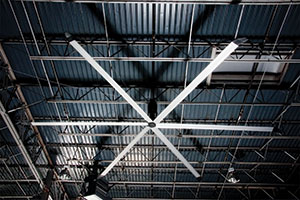
Fan Control
Today's large industrial fans are deployed for more than just cooling.
- By Dan Linder
- Oct 01, 2012
Large industrial fans are designed to create a more comfortable environment, cooling work places down in the summer and helping to keep them warm in the winter months. But over the last decade, these fans have become more versatile than ever imagined as the mass of slow moving air they produce has shown to provide considerable benefits outside of cooling employees, products, and facilities.

Large industrial fans are designed to create a safe, comfortable work environment for employees while helping maintain an energy-efficient facility and improving air circulation and quality.
The blades of these large fans produce a massive, column of air that flows down toward the floor and outward in all directions before drawing it back vertically toward the blades to create what is known as a horizontal floor jet. It is this floor jet that produces the circulation benefits and has caused a subsequent increase in the fans’ popularity among facility managers for controlling conditions in their workplace environments.
In addition to improving temperatures in buildings such as warehouses, distribution centers, manufacturing plants, stadiums, and food/beverage facilities, large industrial fans can help enhance energy efficiency, sustainability initiatives, air quality, and employee safety. And now the next generation of these large-scale fans has arrived—with additional benefits.
Cool and Comfortable
Without question, keeping employees cool and comfortable is what large industrial fans were designed to do when they were first introduced into the material handling market in the mid-1990s. By creating a slow-moving breeze at 2 to 3 miles per hour, facilities have reported a reduction in perceived temperature equivalent to 7 to 11 degrees. This provides a more comfortable work environment for employees, which, in turn, leads to increased productivity.
Air Quality and Product Integrity
Air circulation from the floor jets helps keep not only food and produce fresh to prevent spoilage but also assists in protecting nonperishables by keeping them clean and dry. In addition, many users in refrigerated applications have also seen improvements in their indoor environment’s air quality from running their fans in reverse to destratify the air, creating a more even distribution of oxygen.
Improve Working Conditions
Increasing air circulation and quality helps minimize floor condensation, keeping loading dock areas drier and ultimately safer for foot and fork lift traffic. Additionally, the improved air circulation created by the these large fans can enhance indoor air quality in dry storage and other distribution applications by dispersing the harmful fumes produced by the trucks and forks lifts at the dock door during loading and unloading.
Reduce Energy Consumption
Large industrial fans can be an excellent addition to any overworked HVAC system. They can help regulate a facility’s temperature year-round from floor to ceiling, permitting an increase or decrease in thermostat temperature setting between 3 and 5 degrees without realizing any negative temperature changes--either hot or cold. Managing the internal temperature of a building creates the opportunity to realize energy savings of up to 4 percent per degree change.
LEED the Way
Industrial fans can help companies qualify for and earn credit toward LEED (Leadership in Energy and Environmental Design) Certification in energy efficiency and atmosphere, indoor environmental air quality, and innovation and design. LEED certification provides independent, third-party verification that a building, home, or community was designed and built using strategies aimed at achieving high performance in key areas of human and environmental health that are highly focused on energy savings and increasing air quality.
The fans were designed to create a comfortable work environment while keeping facilities running as energy efficiently as possible. Today, these fans are seeing new and improved uses every day from product sustainability to employee safety and improved air quality from increased circulation, and they continue to prove a valued addition to facilities that can accommodate them.
About the Author
Dan Linder is the sales manager of HVLS Fans for the Carrollton, Texas-based Kelley Company (www.kelleyfans.com). Kelley is a brand owned by 4Front® Engineered Solutions based in Dallas, Texas. 4Front is a leader in the design and manufacture of branded truck and rail loading dock equipment under its brands that include Kelley®, Serco®, LoadHog®, TKO® Dock Doors, APS Resource®, and 4SIGHT™.